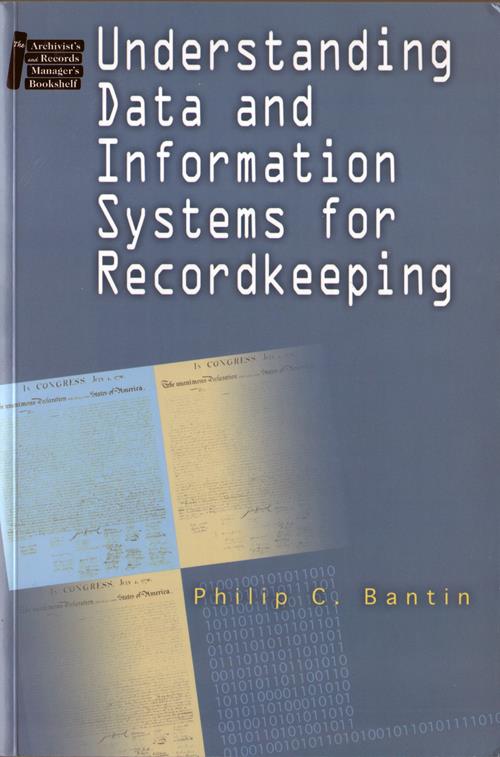Understanding Data And Information Systems For Recordkeeping

Front Cover, Understanding Data And Information Systems For Recordkeeping by Philip C. Bantin, 2008. GGA Image ID # 17250a974f
Understanding Data and Information Systems for Recordkeeping strives to provide a bridge between the theoretical discussions about recordkeeping requirements and specifications that have taken place in our field and the general technical facts available elsewhere. The book reflects the reality that in most cases, you will not be designing a new structure from scratch. Most projects will involve critiquing what currently exists and building future strategies around and through these information systems.
Published by Neal-Schuman Publishers, Inc. New York, 2008, ISBN 978-1-55570-580-0 (alk. paper)
Table of Contents
- List of Figures
- Foreword
- Preface
1. The Impact of Change on the Management of Electronic Records
- Changes in Technology
- Changes in Organizational Structure and Workflow
- The Effect of Change on Records Management
- Models for Managing Electronic Records
- References
2. Recordkeeping Systems
- What Are Records?
- What Is Records Management?
- Primary Functional Requirements for Recordkeeping Systems
- Specific Requirements for Recordkeeping Systems
- The Importance of Metadata
- Key Recordkeeping Metadata
- OAIS Model
- Other Points of Agreement about Recordkeeping Metadata
- References
3. Transaction Processing Systems Constructed on the Relational Database Model
- Technology and Information
- Data and Information
- Information Management Systems
- Transaction Processing Systems
- Database Structures
- Transaction Processing Systems as Recordkeeping Systems
- Making Transaction Processing Systems Better Recordkeeping Systems
- References
4. Enterprise Document Management and Content Management Systems
- Document Management Systems in the Early to Mid 1990s
- Early to Mid 1990s Document Management Systems as Recordkeeping Systems
- Changes in Enterprise Document Management Systems in the Last Decade
- Modern Document Management/Records Management Applications as Recordkeeping Systems
- References
5. Decision Support Systems and Data Warehouses
- Decision Support Systems
- Executive Information Systems (EIS)
- Artificial Intelligence: Expert Systems
- Artificial Intelligence: Data-Mining
- On-Line Analytical Processing (OLAP) Systems
- Business Intelligence (BI)
- Operational Data
- Operational Data Store
- Data Marts
- Data Warehouses
- Decision Support Systems Based on the Data Warehouse as Recordkeeping Systems
- Making Data Warehouses Better Recordkeeping Systems
- References
6. E-mail Management
- Legal Cases Involving E-mail
- Court Cases Involving Discovery and Preservation of E-mail
- Lessons Learned from the Legal Cases
- Surveys on E-mail Management Contents
- Strategies for Making Retention Decisions
- Strategies for E-mail Management
- References
7. Laws, Regulations, and Best Practices Relating to Electronic Records Management
- Laws and Acts
- Impact of SOX
- Rules and Regulations
- Guidelines and Best Practices
- Lessons Learned from the Laws, Regulations, and Best Practices
- References
8. Conclusion
- Progress
- Challenges
- References
- Index
- About the Author
List of Figures
- Figure 1.1: Technology Shifts
- Figure 1.2: Networked Organizations
- Figure 2.1: OAIS Content Information Object
- Figure 2.2: OAIS Preservation Description Information
- Figure 3.1: Relational Database Design
- Figure 3.2: Data Models Depicting Entities and Relationships
- Figure 3.3: Data Models Depicting Attributes
- Figure 3.4: Representation of the File Management Structure
- Figure 3.5: Hierarchical Database Structure
- Figure 3.6: Network Database Model
- Figure 3.7: Strengths and Weaknesses of the Different Structures
- Figure 3.8: Example of a Table in a Relational Database
- Figure 3.9: Example of a Data Dictionary
- Figure 3.10: PeopleSoft Effective Dated Records
- Figure 3.11: Example of Effective Dating
- Figure 3.12: Conceptual Design of Portal, Applications, and Infrastructure
- Figure 3.13: EDEN Workflow Engine and Electronic Recordkeeping
- Figure 4.1: Logical Model of the EDMS Architecture
- Figure 4.2: DoD Comparison of FileNet and ForeMost
- Figure 4.3: Enterprise Content Management Functionality
- Figure 5.1: Three-Dimensional Data Cube
- Figure 5.2: Differences between Operational Data and Derived DSS Data
- Figure 5.3: Wholesale Database Snapshot
- Figure 5.4: Selective Database Snapshot
- Figure 5.5: Cumulative Database Snapshot
- Figure 5.6: Data Integration Process
- Figure 5.7: Fact Table
- Figure 5.8: Dimension Table
- Figure 5.9: Creation of Relationship Artifacts
- Figure 5.10: Architecture of a Distributed Data Warehouse
- Figure 7.1: Smaller Company Cost Summary
- Figure 7.2: Larger Company Cost Summary
- Figure 7.3: Relationships in COSO
- Figure 7.4: Relationships between SOX, SEC, COSO, and CobiT
Library of Congress Catalog Listing
- Personal name: Bantin, Philip C.
- Main title: Understanding data and information systems for recordkeeping / Philip C. Bantin.
- Published/Created: New York : Neal-Schuman Publishers, c2008.
- Description: xiii, 331 p. : ill. ; 23 cm.
- ISBN: 9781555705800 (alk. paper); 1555705804 (alk. paper)
- LC classification: HF5736 .B25 2008
- Contents: The impact of change on the management of electronic records -- Recordkeeping systems -- Transaction processing systems constructed on the relational database model -- Enterprise document management and content management systems -- Decision support systems and data warehouses -- E-mail management -- Laws, regulations, and best practices relating to electronic records management.
- LC Subjects: Records--Management. Electronic information resources. Database management. Business records--Management--Data processing.
- Notes: Includes bibliographical references and index.
- Series: The archivist's and records manager's bookshelf
- LCCN: 2007034855
- Dewey class no.: 651.50285
- Other system no.: (OCoLC)ocm76282392; (OCoLC)76282392
- Type of material: Book
